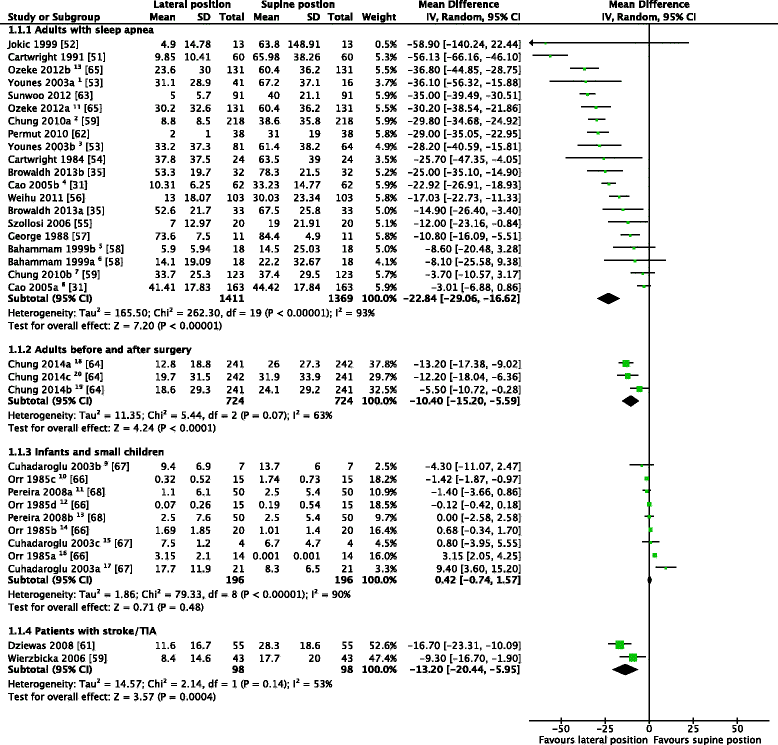Is the supine position associated with loss of airway patency in unconscious trauma patients? A systematic review and meta-analysis
- PMID: 26129809
- PMCID: PMC4486423
- DOI: 10.1186/s13049-015-0116-0
Is the supine position associated with loss of airway patency in unconscious trauma patients? A systematic review and meta-analysis
Abstract
Background: Airway compromise is a leading cause of death in unconscious trauma patients. Although endotracheal intubation is regarded as the gold standard treatment, most prehospital providers are not trained to perform ETI in such patients. Therefore, various lateral positions are advocated for unconscious patients, but their use remains controversial in trauma patients. We conducted a systematic review to investigate whether the supine position is associated with loss of airway patency compared to the lateral position.
Methods: The review protocol was published in the PROSPERO database (Reg. no. CRD42012001190). We performed literature searches in PubMed, Medline, EMBASE, Cochrane Library, CINAHL and British Nursing Index and included studies related to airway patency, reduced level of consciousness and patient position. We conducted meta-analyses, where appropriate. We graded the quality of evidence with the GRADE methodology. The search was updated in June 2014.
Results: We identified 1,306 publications, 39 of which were included for further analysis. Sixteen of these publications were included in meta-analysis. We did not identify any studies reporting direct outcome measures (mortality or morbidity) related to airway compromise caused by the patient position (lateral vs. supine position) in trauma patients or in any other patient group. In studies reporting only indirect outcome measures, we found moderate evidence of reduced airway patency in the supine vs. the lateral position, which was measured by the apnea/hypopnea index (AHI). For other indirect outcomes, we only found low or very low quality evidence.
Conclusions: Although concerns other than airway patency may influence how a trauma patient is positioned, our systematic review provides evidence supporting the long held recommendation that unconscious trauma patients should be placed in a lateral position.
Figures






Similar articles
-
Does turning trauma patients with an unstable spinal injury from the supine to a lateral position increase the risk of neurological deterioration?--A systematic review.Scand J Trauma Resusc Emerg Med. 2015 Sep 17;23:65. doi: 10.1186/s13049-015-0143-x. Scand J Trauma Resusc Emerg Med. 2015. PMID: 26382216 Free PMC article.
-
Drugs for preventing postoperative nausea and vomiting in adults after general anaesthesia: a network meta-analysis.Cochrane Database Syst Rev. 2020 Oct 19;10(10):CD012859. doi: 10.1002/14651858.CD012859.pub2. Cochrane Database Syst Rev. 2020. PMID: 33075160 Free PMC article.
-
Infant position in neonates receiving mechanical ventilation.Cochrane Database Syst Rev. 2016 Nov 7;11(11):CD003668. doi: 10.1002/14651858.CD003668.pub4. Cochrane Database Syst Rev. 2016. PMID: 27819747 Free PMC article.
-
Positioning for acute respiratory distress in hospitalised infants and children.Cochrane Database Syst Rev. 2022 Jun 6;6(6):CD003645. doi: 10.1002/14651858.CD003645.pub4. Cochrane Database Syst Rev. 2022. PMID: 35661343 Free PMC article.
-
Videolaryngoscopy versus direct laryngoscopy for adult patients requiring tracheal intubation.Cochrane Database Syst Rev. 2016 Nov 15;11(11):CD011136. doi: 10.1002/14651858.CD011136.pub2. Cochrane Database Syst Rev. 2016. Update in: Cochrane Database Syst Rev. 2022 Apr 4;4:CD011136. doi: 10.1002/14651858.CD011136.pub3. PMID: 27844477 Free PMC article. Updated.
Cited by
-
New clinical guidelines on the spinal stabilisation of adult trauma patients - consensus and evidence based.Scand J Trauma Resusc Emerg Med. 2019 Aug 19;27(1):77. doi: 10.1186/s13049-019-0655-x. Scand J Trauma Resusc Emerg Med. 2019. PMID: 31426850 Free PMC article.
-
Multiple trauma management in mountain environments - a scoping review : Evidence based guidelines of the International Commission for Mountain Emergency Medicine (ICAR MedCom). Intended for physicians and other advanced life support personnel.Scand J Trauma Resusc Emerg Med. 2020 Dec 14;28(1):117. doi: 10.1186/s13049-020-00790-1. Scand J Trauma Resusc Emerg Med. 2020. PMID: 33317595 Free PMC article.
-
Implementation of new guidelines in the prehospital services: a nationwide survey of Norway.Scand J Trauma Resusc Emerg Med. 2019 Aug 29;27(1):83. doi: 10.1186/s13049-019-0660-0. Scand J Trauma Resusc Emerg Med. 2019. PMID: 31464620 Free PMC article.
-
The prevention of pressure injuries in the positioning and mobilization of patients in the ICU: a good clinical practice document by the Italian Society of Anesthesia, Analgesia, Resuscitation and Intensive Care (SIAARTI).J Anesth Analg Crit Care. 2022 Jan 31;2(1):7. doi: 10.1186/s44158-022-00035-w. J Anesth Analg Crit Care. 2022. PMID: 37386656 Free PMC article.
-
Safety of the lateral trauma position in cervical spine injuries: a cadaver model study.Acta Anaesthesiol Scand. 2016 Aug;60(7):1003-11. doi: 10.1111/aas.12714. Epub 2016 Mar 7. Acta Anaesthesiol Scand. 2016. PMID: 26952653 Free PMC article.
References
-
- Sasser S, Varghese M, Kellermann A, Lormand JD. 2.2.1 The need. In: Sasser S, Varghese M, Kellermann A, Lormand JD, editors. Prehospital trauma care systems. Geneva: World Health Organization; 2005. pp. 7–8.
-
- Smith CE, Walls RM, Lockey D, Kuhnigk H. Advanced Airway Management and Use of Anesthetic Drugs. In: Søreide E, Grande CM, editors. Prehospital Trauma Care. New York: Marcel Dekker, Inc; 2001. pp. 203–253.
-
- PHTLS Committee of NAEMT . Airway and Ventilation. In: McSwain NE, editor. PHTLS - Basic and Advanced Prehospital Trauma Life Support. 7. St. Louis: Mosby JEMS, Elsevier; 2011. pp. 133–177.
-
- American College of Surgeons Committee on Trauma . Airway and Ventilatory Management. In: Rotondo MF, editor. Advanced Trauma Life Support for Doctors - Student Course Manual. 9. Chicago: American College of Surgeons; 2012. pp. 30–49.
Publication types
MeSH terms
LinkOut - more resources
Full Text Sources
Other Literature Sources
Medical

